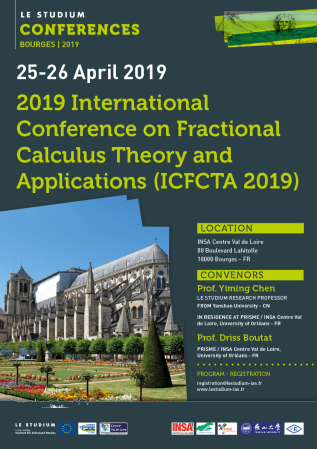Prof. Yiming Chen

From
In residence at
PRISME / INSA Centre Val de Loire, University of Orléans - FR
Host scientist
Prof. Driss Boutat
PROJECT
Observer Design for Distributed-Parameter Systems and Fractional Order Systems
The objective of the proposed project is to strengthen the research and teaching of the laboratories of PRISME, LMR, U930 INSERM and INSA Centre Val de Loire (CVL) in the region Centre, and to create the link among these laboratories, INSA CVL and Yanshan University. In this project, two series of courses on partial differential equations and fractional calculus will be provided in English by Prof. Chen for the students and for the researchers in the form of seminar in the universities and laboratories in the region Centre. These courses will be organized in INSA CVL every year during the visit of Prof. Chen. The proposed research project is on observer design for distributed-parameter systems and fractional order systems, and applications to nonlinear acoustics and viscoelastically damped structures. This is an interdisciplinary research project, where the observer theory will be developed and applied to other fields as a new concept. Four researchers in the region Centre will be involved in the project: Prof. Boutat (the host scientist) and Dr. Liu belonging to the PRISME Laboratory, Dr. Serra and Dr. Dos Santos belonging to the laboratories of LMR and U930 INSERM respectively. Meanwhile, they also belong to INSA CVL, where they will work with Prof. Chen.
Publications
In this paper, a non-asymptotic pseudo-state estimator for a class of commensurate fractional order linear systems is designed in noisy environment. Different from existing modulating functions methods, the proposed method is based on the system model with fractional sequential derivatives by introducing fractional order modulating functions. By applying the fractional order integration by parts formula and thanks to the properties of the fractional order modulating functions, a set of fractional derivatives and fractional order initial values of the output are analogously obtained by algebraic integral formulas. Then, an explicit formula of the pseudo-state is accomplished by using the fractional sequential derivatives of the output computed based on the previous results. This formula does not contain any source of errors in continuous noise-free case, and can be used to non-asymptotically estimate the pseudo-state in discrete noisy case. The construction of the fractional order modulating functions is also shown, which is independent of the time. Finally, simulations and comparison results demonstrate the efficiency and robustness of the proposed method
In this paper, an effective numerical algorithm is proposed for the first time to solve the fractional visco-elastic rotating beam in the time domain. On the basis of fractional derivative Kelvin–Voigt and fractional derivative element constitutive models, the two governing equations of fractional visco-elastic rotating beams are established. According to the approximation technique of shifted Chebyshev polynomials, the integer and fractional differential operator matrices of polynomials are derived. By means of the collocation method and matrix technique, the operator matrices of governing equations can be transformed into the algebraic equations. In addition, the convergence analysis is performed. In particular, unlike the existing results, we can get the displacement and the stress numerical solution of the governing equation directly in the time domain. Finally, the sensitivity of the algorithm is verified by numerical examples.
In this paper, firstly, a new method which makes a modification of the Bern-stein polynomials is introduced to solve the linear fractional partial differential equations (FPDEs). The biggest advantage of the fractional Bernstein polynomials is that the order can be changed with the order of the fractional partial differential equations. For the first time, we try to use this method to solve the linear fractional partial differential equations. Secondly, convergence analysis and error correction are also given to make the calculation results more accurate. The concrete content of this method and error correction are explained briefly and numerical examples are given to demonstrate the validity and accuracy of the method.
This paper applies a numerical method of polynomial function approximation to the numerical analysis of variable fractional order viscoelastic rotating beam. First, the governing equation of the viscoelastic rotating beam is established based on the variable fractional model of the viscoelastic material. Second, shifted Bernstein polynomials and Legendre polynomials are used as basis functions to approximate the governing equation and the original equation is converted to matrix product form. Based on the configuration method, the matrix equation is further transformed into algebraic equations and numerical solutions of the governing equation are obtained directly in the time domain. Finally, the efficiency of the proposed algorithm is proved by analyzing the numerical solutions of the displacement of rotating beam under different loads.
An innovative numerical procedure for solving the viscoelastic column problem based on fractional rheological models, directly in the time domain, is investigated. Firstly, the governing equation is established according to the fractional constitutive relation. Secondly, the resulting equation is transformed into algebraic equation and solved by using the shifted Chebyshev wavelet function. Furthermore, the convergence analysis and the retained numerical benchmarks are carried out to validate the performance of the proposed method. A small value of the absolute error between numerical and accurate solution is obtained. Finally, the dynamic analysis of viscoelastic beam-column problems is investigated with different cross-section shape (circular and square) under various loading conditions (axial compressive force and harmonic load). The displacement, strain and stress of the viscoelastic column at different time and position are determined. The deformation and stress of the viscoelastic column of different materials under the same loading condition are compared. The results in the paper show the highly accuracy and efficiency of the proposed numerical algorithm in the dynamical stability analysis of the viscoelastic column.
In this paper, a fractional viscoelastic model is proposed to describe the physical behaviour of polymeric material. The material parameters in the model are characterized by the experimental data obtained in the dynamical mechanical analysis. The proposed model is integrated into the fractional governing equation of polymethyl methacrylate (PMMA) above its glass transition temperature. The numerical algorithm based on the shifted Legendre polynomials is retained to solve the fractional governing equations in the time-domain. The accuracy and effectiveness of the algorithm are verified according to the mathematical examples. The advantage of this method is that Laplace transform and the inverse Laplace transform commonly used in fractional calculus are avoided. The dynamical response of the viscoelastic PMMA beam is determined with several loading conditions (uniformly distributed load and harmonic load). The effects of the loading condition and the temperature on the dynamic response of the beam are investigated in the results. The proposed approach shows great potentials for the high-precision calculation in solving the fractional equations in the science and engineering.
Final reports
During the past decades, fractional calculus has gained great interest and success in the field of automatic control. The research project was on numerical algorithms and observer design for fractional order systems. Various effective algorithms have been proposed to simulate different kinds of systems. Accurate and robust algebraic observers have been designed to estimate useful system information in noisy environment. An international conference has been held with the support of the project, which provided a platform for researchers to exchange results and advanced technology. Moreover, this project has provided an international collaboration opportunity for faculties and students both from INSA Centre Val de Loire and Yanshan University in China.

